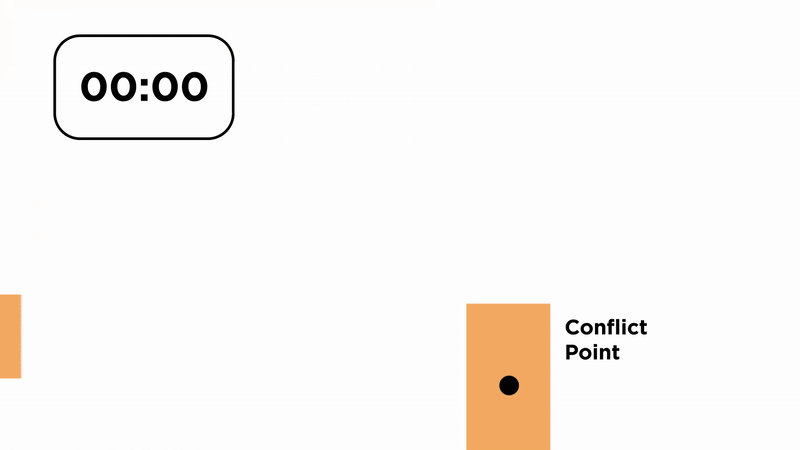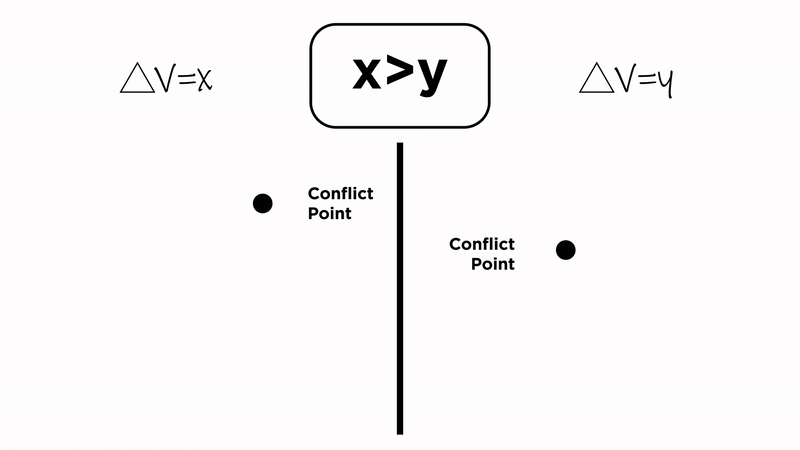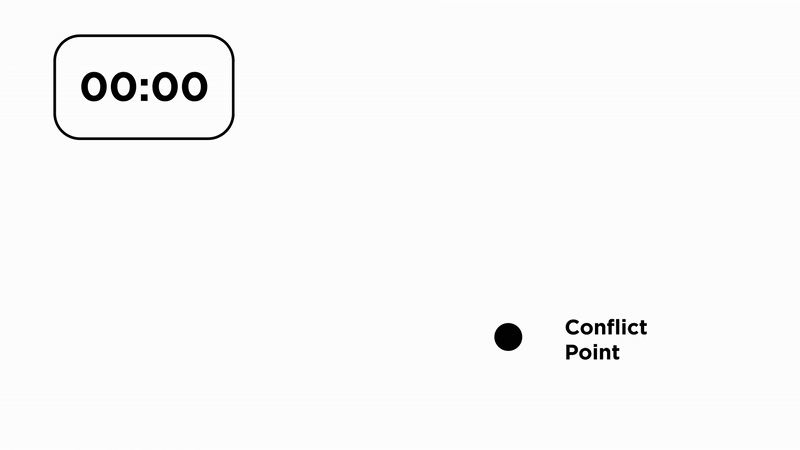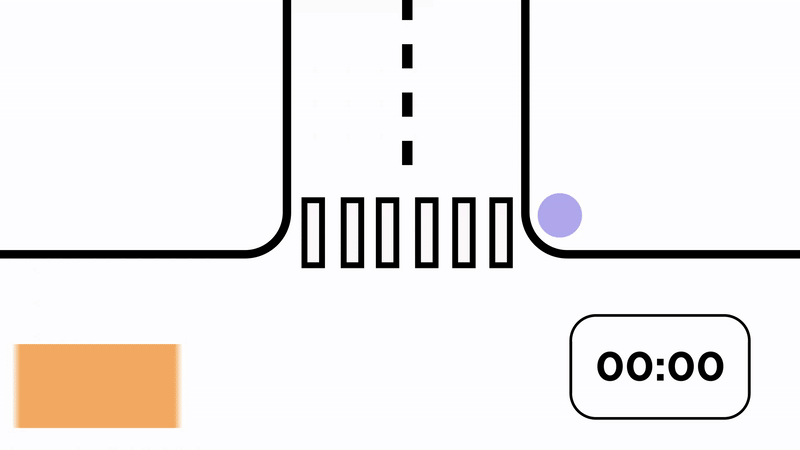May 15, 2025
How can we identify risk factors on roadways before crashes occur? This is the question that a systemic and proactive approach to transportation safety seeks to address. While reviewing crash data can help agencies get a sense of patterns, we don’t want to wait for serious injury or fatal crashes to take place before taking action.
Fortunately, agencies have tools at their disposal to help them proactively identify potential conflicts between vehicles, pedestrians, and bicyclists. One such approach is video-based conflict monitoring. Conflict monitoring means identifying situations, and the corresponding circumstances, that produce near misses. A near miss is when two users almost crash.
Many transportation practitioners are aware of the general concept behind conflict monitoring, but it’s easy to get lost in the terminology when eager engineers start talking about “delta-v” and “MTTC.” In this article, we’ll break down the fundamentals of video-based conflict monitoring and define common conflict monitoring measures, including when and why you might use one metric over another.

Conflict monitoring means identifying situations, and the corresponding circumstances, that produce near misses. A near miss is when two users almost crash.
Surrogate Safety Measures
The Highway Safety Manual tells us that the safety performance associated with a site refers to the number of crashes (by severity) expected to occur within the site boundaries during a unit of time. However, as mentioned above, we don’t want to wait for crashes to recognize where the safety issues are located. In some cases, the roadway or facility is not yet in service, has only been in service for a short time, or crash frequencies have not been collected (it typically requires years of crash data to uncover reliable patterns). Additionally, while people walking and biking are overrepresented in crash data, at the intersection level, crashes are still rare enough to make drawing statistically meaningful conclusions difficult. This is where surrogate safety measures come in.
A surrogate safety measure is an indirect way of measuring roadway safety performance. While not a one-to-one replacement for measuring crashes, surrogate measures can help us assess safety performance through measuring things that correlate to crashes. Surrogate safety measures include potential conflicts between users, collision avoidance behaviors (such as evasive actions or excessive deceleration), and road user behaviors (such as traffic violations, lane encroachments, or delayed reaction time). The degree to which a surrogate measure provides a reliable indication of safety performance can vary from measure to measure. The stronger the correlation between the surrogate measure and crash frequency or severity, the more reliable of a measure it is.
Conflicts as a Surrogate for Crashes
Conflict monitoring is built on the understanding that higher concentrations of conflicts indicate a greater likelihood of crashes if left unresolved. As the name suggests, video-based conflict monitoring uses cameras to record road user interactions at intersections, and software to flag potential conflicts, or near misses, within the footage.
The effectiveness of measuring conflicts as a surrogate for crashes has been supported by studies like PennDOT’s Smart Intersections study, in which engineers selected 15 intersections across Pennsylvania and manually reviewed 100 events at each intersection that were flagged by video-based software. They compared the events they confirmed to be conflicts against five years of crash data and found a strong correlation.
So, how are conflicts measured? Here are a few of the surrogate safety measures commonly used:
- Time to collision (TTC) predicts the time remaining before a crash would occur if the paths and speeds of two road users are maintained. A smaller value indicates a higher likelihood of a collision. This measure can be used for all road users.

- Post encroachment time (PET) measures the lapsed time from when a road user leaves a specific location, or conflict point, to when another user arrives at that location. A smaller value indicates a higher likelihood of a collision. While it can be used for all road users, PET has some limitations, which we’ll discuss later on.

- Delta-v represents the change in vehicle velocity in the event of a collision. This measure is used with other surrogates to add supplemental information about crash severity. A larger value indicates a more severe crash.

- Modified time to collision (MTTC) predicts the time to collision that includes consideration of the likely deceleration of the involved road users. A smaller value indicates a higher likelihood of a collision. MTTC is typically used to evaluate rear-end conflicts.

- Deceleration rate to avoid a crash (DRAC) is the minimum required deceleration rate a vehicle has to apply to avoid a crash. A larger value indicates a higher likelihood of a collision.

Video-based monitoring can also identify other safety issues like red light violations and speed violations, both of which are known to lead to collisions.
When to Use Conflict Monitoring
While video-based conflict monitoring can have a number of use cases, its two primary uses are:
1. Prioritizing improvements, especially around pedestrians and bicyclists or other low-frequency/high-severity crash types. If 70 intersections each have one pedestrian or bicyclist crash documented, how do you prioritize where to install countermeasures at first? Creating a database of comparable counts of conflicts will aid your prioritization.
2. Evaluating the effectiveness of countermeasures. Video analytics can be used to compare conflicts before and after a change was implemented to see if it made a difference. Measuring conflicts rather than crashes in before/after studies can dramatically shrink the timeline needed to complete the study, while also offering a larger dataset to work with.
Keys to Success with Video-Based Conflict Monitoring
When using any surrogate safety measure, you’ll still need to do some post-processing to get the most accurate results. Human review and judgment is required to verify the data that software can pull from video monitoring depicts true conflicts. For example, some encounters—like a pedestrian waiting for a car to pass and then crossing the street, or a permissive left-turn made after a through vehicle passes by—could have a PET of less than two seconds, a common threshold for potential conflicts, while being a legal, safe interaction. Human judgment must always be part of the equation.

In this example, the short post encroachment time (PET) points to a near miss between a driver and pedestrian.

However, in this example, the pedestrian crosses the street right after the driver makes a turn - a legal, safe interaction despite a short PET.
Additionally, it’s important to be consistent when picking a conflict monitoring measure as well as a vendor who can provide the video-based conflict monitoring service. Different vendors may have different definitions of the measures (for example, one may measure PET using the edge of the vehicle while another measures it using the center, which makes a difference when you’re comparing milliseconds). Since industry conflict measures aren’t standardized, picking one vendor and sticking to their definition consistently makes your before/after data reliable. Further, not all vendors offer the same performance measures, so be sure to understand what they offer and whether it will meet your needs. Need help selecting a vendor? Reach out! We’ve worked with several and are happy to suggest questions to ask and features to consider.
Continue the Conversation
These technologies are promising tools in the quest to prevent serious crashes on our roadways, providing a practical avenue for transportation practitioners to be proactive in our approach to detecting and reducing safety issues. This is a rapidly evolving topic, and we welcome further questions, observations, and success stories! Read more about PennDOT’s Smart Intersections study here, and don’t hesitate to reach out to continue the conversation.
